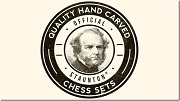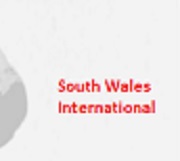1898-1972
FIRST MOVES
CHESS IN THE 1890s
There was a surge in interest in chess in South Wales in the late 19th century leading to the establishment of a South Wales Chess Association in 1888, but there was still no club in Bridgend. However, competitive matches between clubs as far afield as Swansea and Newport were being played in the Wyndham Hotel as a mutually agreed central venue and this must have been an incentive for anyone interested in the game in the town.
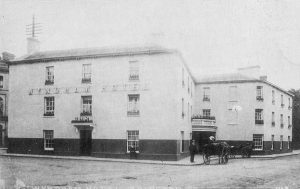 The Wyndham Hotel, Bridgend
The Wyndham Hotel, Bridgend
One of the first signs of active chess in Bridgend is a message from the Cambrian newspaper to an F. Hewson of Bridgend to tell him that his problem compositions were not up to standard!! Hardly an incentive to stick at it!
The earliest mention of a club in the town is to be found in the minutes of Cardiff Chess Club. A letter had been received, dated 27th November, 1897, challenging the Cardiff club to a match. At a committee meeting this was discussed and appears not to have been taken very seriously as the club secretary, Mr. A. H. N. Reddaway, suggested that, in order to test out the opposition, he offer his services instead in a simultaneous display at the Bridgend club. On the 8th January he reported back that he had played nine games and won five of them. As he was by no means one of the stronger players at Cardiff, he therefore proposed that the Cardiff second team might be suitable for such a fixture. No response is recorded.
The first match report for any club in the area was in March 1898 when Bridgend defeated Barry 9-7. In those days play continued if a game finished early and it was quite common to play two games on the same board. There were nine boards and Bridgend lost 0-6 on the top three boards but dominated elsewhere.
Bridgend was led and captained by F. J. Richardson and that historic team was then made up of Edward Thornton, age 55, former teacher and superintendent of the Cottage Homes (he resigned in 1899 and moved from the area) and secretary of the Glamorgan Beekeepers’ Association; John Sankey, age 28, a grocer in Dunraven Place; William H. John, aged 35, another grocer in the same street who was President of the Chamber of Trade 1907; R. T. Bevan, a clerk in the Metropolitan bank ; J. H. Cooper, age 23, another banker, who had moved to London within a few years; W. H. Barker; William R. Randall, age 48, a solicitor and member of the same family that served as agents for the Dunraven estate for most of the 19th century, and his son, Harry J. Randall, aged 20, also a solicitor who lived at Highmead, Bridgend.
One can see that the profiles of these players do not fit the Victorian stereotype of old men from privileged backgrounds with the time and money to be able to indulge themselves. The Bridgend team represented a new breed of chess player, middle class working men; men with an educational background. Some of the players remain unidentified. This may be because of mis-spellings in the press (e.g. W. H. Barker appears on one occasion as Burker), or maybe because they were only in the area for a brief period of time. Quite often with these new emerging clubs the leader dragged in people to make up the team who were working with or for him and, in that vein, Richardson might have been someone in authority at the bank but that is mere supposition.
The results of five matches 1898-9 were published in the Cambrian and Bridgend seems to have had a good group of active players to choose from. Once they settled their strongest line-up, the top boards seemed to be W.R. Randall, Dr. Duncan Cooper, W. H. Barker and William H. John. Dr. Cooper, who was head of the local Health Board, had left Bridgend by the end of 1902.
FRIENDLIES ONLY
CHESS IN THE 1900s
The Bridgend club continued to meet and have the occasional friendly match, but participation in the South Wales Challenge Cup was still not considered an option, probably due to the travelling difficulties. Between 1898 and 1903 there was no South Wales Challenge Cup competition anyway.
The club was fortunate to enlist the services of A. W. Daniel. He won the first open chess tournament to be held in South Wales, at the Cardiff club in January 1903. It was a knock-out tournament with 59 entries and he won a Staunton chess set valued at 43 shillings. Arthur William Daniel (1878-1955) was from Fenton near Stoke-on-Trent and had qualified in London as a pharmacist. He began work at the Bridgend Mental Hospital towards the end of 1902 and remained there until World War 1. Between 1898 and 1953 he composed 1750 problems and was an expert at two-movers and three-movers.
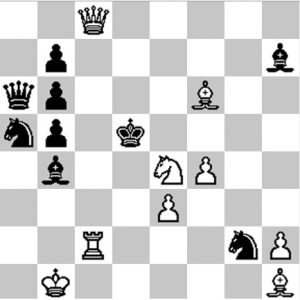
A problem of A.W.Daniel that won first prize in the “Year Book of Chess” Competition 1908.
White to play and mate in 3.
Solution: 1. Qd7+ Kxe4 2. Bxg2+ Kxe3 3. Qd4++
His work was published in the Cheltenham Examiner, Reading Observer, Falkirk Herald and Staffs Sentinel as well as the British Chess Magazine. He won the Bronze Medal at the American Chess Congress Tourney 1903-4. A. W. Daniel acted as Hon. Secretary of the British Chess Problem Society and became one of its most distinguished Presidents 1945-7. After World War 1 he moved to Wanstead, London and played for Leyton Chess Club. He died on 13th February 1955.
In 1903 the club was meeting at the Dunraven Restaurant. The leading players were A.W. Daniel, W. H. John, John Sayer, Alfred O.D. Evans, and Vincent Piercey (1880-1923) a bank clerk.
In a match on 13th February 1903, Mrs. Elizabeth McGaul became the first lady to play for Bridgend. Her husband, William McGaul, who played on a higher board, was originally from Trefriw in North Wales. He was a member of the town council and was adopted as the conservative candidate in 1895 for the county elections. He was a quarry owner and proprietor of Quarrella Brickworks.
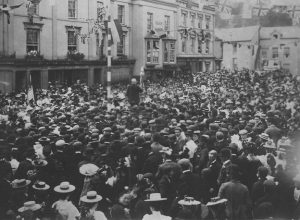
William McGaul making a speech in Bridgend
In 1905 the man who led the Bridgend team was John D. Chambers (1845-1930). He was a remarkable man; a Scottish wine salesman, he was Scottish champion in 1891, BCCA champion 1918-9 and South Wales champion 1924 and 1927 when into his eighties, but he was most famous for setting up chess clubs all over the country. Wherever he visited a new club sprang up.
When he played in the 1926 South Wales Championships he was said to be, “Fortified by a bottle of smelling salts and a flask of tea, from which he incessantly sought refreshment”.
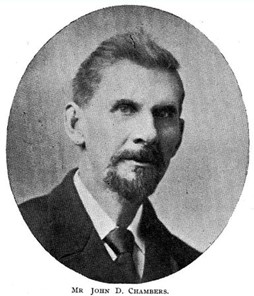
A match result survives from October 1905 when Bridgend entertained Barry over 11 boards. The result was a tie 7.5-7.5. Bridgend had Chambers playing on top board although he was still playing for Sale in Cheshire! A.W.Daniel played on Board 2.
In November 1906 a newly formed club was announced at the YMCA by the association secretary, Mr. M. J. Letcher. There seem to have been two clubs in the town at this time, though that was probably short-lived. A match was arranged between the Town and the YMCA . The town were led by A. W. Daniel, W. A Whitton, J. W. Walton and W. McGaul whilst the YMCA had C. V. Sayer, J. Sankey, Vincent Piercey and Evan J. Thomas at their top order.
By the following year the two clubs had merged and the board order was Chambers, Daniel, Whitton, W.H.John, Sayer and Piercey, with Sankey and McGaul on the lower boards.
William A.Whitton was a science teacher at the Bridgend County School and left for London in 1907. He is probably the same person who was playing for Northampton chess club in 1950.
Charles Vincent Sayer was born in Suffolk 1858 and became superintendent of Bridgend Cottage Homes, his wife being matron. He died in Surrey in 1951.
Piercey, aged 26, was from Birmingham and was engaged in Bridgend as a bank clerk.
The South Wales Chess Association catered for clubs as far afield as Newport and Llanelli. Clubs could affiliate and participate in the Challenge Cup or not as they desired. Bridgend were entered for the Cup in 1906 but only the match result against Barry is known.
COMPETITIVE CHESS
CHESS IN THE 1910s
It may be of interest that there was briefly a club at Nantyfyllon. In October 1910 they travelled to Bridgend to play a friendly match in the Wyndham Hotel. Bridgend won easily enough 16-3 over 8 boards. The Bridgend top three A.W. Daniel, C. V. Sayer and V. A. Piercy scored eight points between them.
The club continued to be led by A. W. Daniel until he left for London about 1914.
In 1910 Bridgend again participated in the South Wales Challenge Cup. They beat Swansea 4.5-1.5 but did not progress to the final.
Unfortunately, surviving full match details are few and far between.
The club continued to compete in the Cup until 1914. A booklet was printed by the SWCA for 1914-5 which acted as a rule book and as a fixture list. The Bridgend club is mentioned as meeting every Tuesday and Thursday at the Wyndham Hotel, the Honarary Secretary being Mr. W. F. Tudor of Ravenhurst, Bridgend. However, the club did not take part in the Cup that year.
J. D. Chambers visited the club in November 1910. He was already a Vice-President of the club, though his retirement and further chess career was spent around the Cardiff area, and his visit was marked by a simultaneous display. He took on 8 opponents and played 10 games, losing twice to A. W. Daniel and drawing his game with H. J. Randall.
Walwin F. Tudor, (1877-1933) a town surveyor, and his wife Mary, both played for the club during this period.
In February 1911 the mighty J. H. Blackburne visited, played 16 and won 14 of his games. He conceded two draws – one with A. W. Daniel and the other with T. Samuel of Nantymoel. He was most impressed with the play of the latter as he narrowly avoided defeat.
After the departure of A. W. Daniel, Thomas Samuel took over the top board spot above Tudor, H. J. Randall and Piercy. Thomas Samuel (b. 1882) hailed from Brynamman and, after attaining a degree at Aberystwyth, taught science in Maidenhead and Abergele before arriving in the Bridgend area in 1910. Whilst in North Wales he helped form a club at Abergele in 1908 which joined the fledgling North Wales Chess Association. Clubs played for the J. D. Chambers trophy – presented by the same person who was associated with the Bridgend club. From the games that survive he seems to have been unbeaten and one of his wins was against the area’s leading player, J. Ellis Parry, who had participated in the British Championships. Samuel played in the North Wales team in the 1908 inaugural match against Cheshire and by 1910 had been elevated to Board 2 in the county side.
In Bridgend he took charge of the science classes in both Ogmore and Garw Higher Elementary Schools until 1919 when he was appointed county lecturer on Physics and Chemistry in Mining. Unfortunately, his appearances for the Bridgend club were limited due to the onset of war.
HIGH SPOTS AND LOW SPOTS
CHESS IN THE 1920s and 1930s
Chess resumed in South Wales in 1919 and a year later Bridgend returned to the fray. They continued to compete in the Challenge Cup until 1928 and the nearest they came to victory was losing on tie-break to Cardiff in 1925, the latter going on to narrowly beat Newport in the final.
Claude Hybart led the team in 1924. He had recently arrived from Barry where he had played on top board. Behind him were R. G. Kyte, J. P. Harris, G. E. Chappell, H. Haydn, James Bragg and D. Thomas. Harris played as high as board 7 in the county team and ahead of both Chappell and Kyte. Horace Haydn had played in the match against Barry in 1906.
The following year they won their section of the Cup competing against Porth & Cymmer, Porthcawl and Mountain Ash, but lost the final to Cardiff 2.5-3.5.
One of the leading lights in the Bridgend club of this era, indeed, one of the leading administrators in South Wales was Robert G. Kyte (1879-1961). He was a mechanical engineer and made a living selling machinery. Born in Newport, he lived in Dinas Powis prior to moving to Bridgend. He spent most of his life in Heol Gam, Bridgend. He was a high-ranking freemason being Past Master of the Ogmore Lodge 1928 and 1929, and one of the founders and first Master of Penybont Lodge 6743 in 1948. Mr. Kyte was secretary for the South Wales Chess Association from 1915 to 1935 (though during the Depression there was not much chess being played), and for a short while in 1927 he ran columns in the Evening Express and the South Wales News. He also did the bulk of the administrative work in successfully bringing the British Chess Championships to Tenby in 1928.
The South Wales C. A. collapsed around 1930 and took five years to recover. Bridgend were slow to re-enter the fray and Mr. Kyte played for Port Talbot YMCA 1936-8. He was made a Vice President of SWCA in 1935 and remained so until its demise in 1954. He played his last game for Bridgend in 1951.
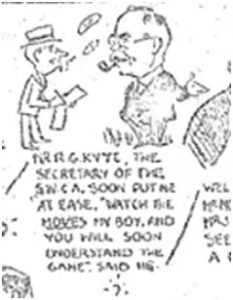
Cartoon showing R. G. Kyte and a reporter at the South Wales Championships 1926.
Another able administrator within the club was George E. Chappell (1888-1954) of Stanton House, Morfa Street. He was born in Ystalyfera and became a secondary school teacher in Bridgend, living in Wyndham Crescent. Mr. Chappell ran the South Wales postal chess team that competed in the Counties’ Championships between 1923 and 1930. Chappell was a Vice-President of SWCA from 1947 to 1954.
On 23rd February 1922, the Serbian grandmaster, Boris Kostic, visited Bridgend following competition at the Hastings Chess Congress, on a tour of the South Wales clubs. He took on 20 opponents, winning 17 and three were recorded as ‘unfinished’ with neither party willing to concede. They were Parry Evans, Peile and Frank Jarvis.
Three years later, on 17th February 1925, the British player, F.D. Yates gave a simultaneous display at Bridgend as part of his tour. He won the British Championship six times between 1913 and 1931. Despite only having 11 opponents, he lost two to C. Hybart and F. Jarvis.
Claude Hybart was the son of Francis Hybart who had led the first Barry Chess Club. He competed in the South Wales Championships of 1926 but four years later was playing for the new club at Port Talbot. He also played for the clubs at Barry and Porthcawl.
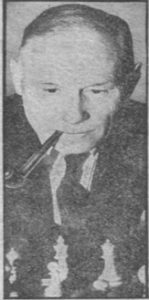
Claude Hybart
Frank Jarvis was from Porthcawl and he too played in the South Wales Championships of 1925-1928. In 1926 he was referred to as wearing,” a charming blue tie and an inscrutable smile, and essayed the demoralising effect of a nonchalant attitude.” The display at Porthcawl a day earlier had been cancelled hence the appearance of these two players.
A surprising entry to the South Wales competition in the 1921-2 season was Ogmore Vale. Valley clubs were popping up right across South wales at this time as Miners’ Institutes flourished. The 1920s was a boom time for chess until the General Strike and following Depression. Travelling would have been a major problem for teams playing against Ogmore Vale and for the club itself so it was no surprise that not all their matches were played. The team was led by 42 year old Henry J. Bothwell, with Tom Evans on Board 2 and below them H. Wilkinson, J. Moss and G. Reese. The club did not make another appearance in the competition for 25 years!
A STRONG CLUB – FOR A WHILE
CHESS IN THE 1940s
The Challenge Cup restarted for the 1945-6 season and the following year Bridgend competed in the ‘East’ section of what was now an all-play-all tournament. They continued to compete until 1952 (but not 1949-50), but were by then struggling for players with other clubs at Kenfig Hill & Pyle, Porthcawl and Ogmore Vale competing for membership.
Jacques Mieses visited Bridgend County School on 11th February 1946. He took on 6 players from the Kenfig & Pyle Welfare and 14 from Bridgend, losing only to C. Benson Roberts the club treasurer, and to young J. R. Smith. The latter, from Ogmore-by-sea, had been a pupil at Bridgend County School until the previous term where he had won the school championship. H. Burrow, the club president R. G. Kyte, H. J. Cunningham and a Captain Lloyd drew their games.
Mieses was, at the time of his 1946 tour, 81 years of age! In total he gave 9 displays in 10 days during his South Wales tour, losing 10 and drawing 36 out of 206 games. What a constitution! He stated that “in his long career he has never had a more satisfactory or more enjoyable chess tour.” This remarkable man got out of Germany in 1938 just before war commenced and carried a leg injury which hardly seemed to have affected his prowess at simultaneous chess.
Harold G. Burrows, J. R. Smith, H. G. Chappell, Idris S. Treharne and H. J. Cunningham were the leading club members during this period. Burrows went unbeaten one season, playing on top board. In the 1946-7 season a J. Grayson played on top board, losing three of his seven games. Membership in these years was consistently in double figures and even reached the heady heights of 20. Some however only played one or two matches and tehn disappeared.
Ogmore Vale Workingmen’s Institute re-emerged in the 1947-8 season although, as in the 1920s, not all their matches were played. Their team varied throughout but they were led again by Henry Bothwell and Tom Evans ahead of G. Jenkins, J. Evans, A. Parsons and others.
A new youngster, Ron Stevens joined the Ogmore club later and he, together with Bothwell and Evans played for the South Wales team until 1954 in spite of the fact that they did not play for an affiliated club. Stevens no doubt learnt the intricacies of the game from Bothwell who lived just a few doors away. In the 1950-1 season Bothwell and Evans played in the Cup for the club at Kenfig & Pyle.
A RETURN TO FRIENDLIES
CHESS IN THE 1950s
Bridgend was being squeezed for members by the time that the 1950-1 season started and they only used six players throughout – the two Burrows brothers, J. R. Smith, Treharne, Hughes and Cunningham.
Bridgend’s final season in the SWCA competition was 1951-2. Every away match meant travelling to the Cardiff area where they met Barry, Cardiff, Old Illtydians, Inland Revenue and Crown clubs. They did very well and it was only Cardiff who beat them both home and away to progress. A B. Lenkiewicz was noted as having won his games in both matches for Bridgend against Cardiff.
Bridgend remained affiliated to the SWCA but did not take part in the Challenge Cup for the final two seasons. The East Glamorgan League was formed in 1954.
Two of the club’s stars of this era were the brother Harold (born 1929) and Brian (born 1936), the talented sons of postman, Frederick Burrows.
Harold Burrows had returned to Bridgend after gaining his degree and twice defeated the Monmouthshire champion Harry Pugh in county matches.
His younger brother, Brian, became the first Welsh player to compete in four consecutive Glorney Cup competitions, ending up on top board for the Welsh Under 18 team. He won the Welsh Under 18 title in 1953.
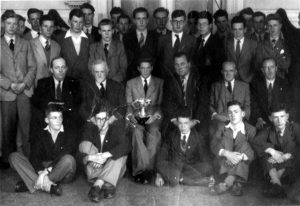
Glorney Cup players in London 1952. Brian Burrows is in the picture somewhere.
J. R. Smith had been secretary of the Bridgend club in the 1950-1 season and that year was also labelled as librarian of SWCA. Smith, Kyte and Cunningham served as delegates for the Association to the parent body, the British Chess Federation.
Henry Cunningham was selected for the management of the new East Glamorgan League in 1954 though he appears to have stayed for just one season. He was however well thought of and in 1960 was appointed to a committee to review the league rules. He was made a Vice-President of SWCA in 1949 or 1950.
A CLUB IN THE WILDERNESS
CHESS IN THE 1960S
The club in the 1960s met above the Milk Bar, near the Rue, but by 1963 had settled at the YMCA, next to the Fire Station at Newbridge Fields. It had struggled to exist outside the league and with no matches being played of any description. Things began to change in the early 60s when Byron Thomas and 17 year old John Trevelyan joined. A year or so later Martyn Griffiths and Roger John, from the Maesteg area, made the journey by bus to add fresh impetus. These new players were all keen and wanted to test themselves.
The group already meeting at the YMCA was quite talented though lacking any incentives to compete in the league. When asked about that possibility the reply was something like, “We did that in the 50s and got fed up of the travelling. We are not doing that again.”
There were only a handful of members. Henry J. Cunningham was the senior figure. He passed away in 1966 and had been absent from the club for about two years due to ill-health. He was 69 when he died. He had been the main administrator of the club for the previous 20 years and was also involved in East Glamorgan chess. (When I became interested in the history of chess in Wales around 1970 I got in touch with his widow only to find that she had burnt all his records, which must have included a lot of data relating to the Bridgend club.) He had played in the first WCU county match in 1955 and in the first match played by Bridgend YMCA on 15th Oct 1964 against Cardiff he was still strong enough to draw on Board 3 against Dr. Wentworth. Perhaps his high regard may be judged by the fact that up until 1970 only three people had been made life members of East Glamorgan – Cunningham was one of those, probably as a result his services as Chairman of the Association from 1960 to 1965.
The strongest player in the club was undoubtedly Bernard Bloch. He was east European in origin and was a lovely man. In friendly games as white he only played the King’s Gambit and if he ever attacked your queen he would announce ‘queen’ in much the same way as one would call ‘check’. He brought his son with him to the club. The latter was 10 or 12 and not a strong player. They emigrated to South Africa. He tried his hand at the Welsh Championships in 1958 scoring only 1½. A year later he managed 3 points and repeated that in 1960. He was keen enough to travel to Cardiff where he played league chess from 1957 to 1960. In 1960 he was in a virtually unassailable position in the very strong Cardiff Club Championship, but because some games were not finished no title was awarded.
The next strongest player was a Porthcawl man, J. R. Smith. He was a craggy customer, both in appearance and in play. You didn’t have a chat with Mr. Smith! He was a club member before Bloch and had competed in the South Wales Championships of 1950 and 1952. With Bloch he travelled to Cardiff to play for that club in the late 50s; and he also played for the East Glamorgan zonal team in the 1954-5 season. Later, he played for Porthcawl.
Bringing up the tail of the older members was a Mr. Pugh. Again, he seemed ancient to the new players but was probably only in his 70s. He was not a strong player but came along each week for the sheer enjoyment of the game.
The rest of the club was made up of new players. Byron Thomas was a good ten years older than the new youngsters and it was he who did all the organising of matches. John Trevelyan was the youngest of the regular players and left soon afterwards to join the R.A.F. Travelling to the first friendly match in Cardiff, Trevelyan and Martyn Griffiths were sitting in the back of a car and decided to play a game of blindfold chess. After 20 odd moves Martyn lost the position but John had it all sorted and quoted where each piece was on the board. It was clear then that he would be the better player.
In that first match the team trounced Cardiff 4.5-2.5. Bloch beat the formidable F. W. Dovey on top board, Smith drew with Joe Lang, Cunningham also drew. The rest of the team consisted of Byron Thomas, John Trevelyan, Martyn Griffiths and Mr. Pugh. A resounding victory!
Those taking part were so thrilled with the win that another match was soon arranged on 29th October away to Pontypridd. Again, Bloch held his own with the recent Welsh champion, John Mills; Byron Thomas played on Board 2, Roger John won on Board 3 and Martyn Griffiths on Board 5, resulting in a 3.5-2.5 victory. A return match was played on 11th November at Bridgend. That was tied 3-3 in spite of Bloch this time beating John Mills; J. R. Smith lost, Mr. Cunningham drew, Byron lost to the Welsh ladies’ champion, Shirley Mills, Roger John won and Martyn Griffiths drew.
A Maesteg team were the next opponents with Roger John (2) and Martyn Griffiths (3) playing for the latter. The secret guest on top board for Maesteg was 14 year old Howard Williams. Bloch and Smith won for Bridgend on the top boards and there were draws on Bd. 3 – Martyn Griffiths against Byron Thomas, and Bd. 4 where a new Bridgend player the Porthcawl teacher Ken Bogue drew. Bridgend won on Board 5 and Mr. Pugh lost on Board 6, so Bridgend won again 4-2. There was no club in Maesteg and this match was merely a group of friends getting together.
Another club that played outside the league was Porthcawl. Bridgend’s first match with them was on 20th February 1965 when David Hambrook for Porthcawl beat a new player, C. M. Cox on top board. Cox was a very useful player and probably in his 40s; he was formerly with Gloucester chess club where his grade had been 7a i.e. 145-152 (around 1800). Roger John, John Trevelyan, Byron Thomas, J. D. Llewellyn and Martyn Griffiths made up the Bridgend team and they all won. Llewellyn was another strong new member, probably in his early 20s and a useful acquisition to the team.
A month later on 25th March the club again travelled to Pontypridd who were looking for revenge. They put out a very strong team with league players on every board and led by Welsh Championship contenders John Mills, Brian Heath, Ian Hopkins and N. J. Davies. The Bridgend team once more came out of top winning 5-3. Bloch lost to Mills, Howard Williams drew with Heath, Byron Thomas lost to Hopkins, and Roger John drew with Davies but on the lower boards – Cox, Llewellyn, Griffiths and Bogue reigned supreme.
The Dragons were a young postal chess team from South Wales run by Roger John and Martyn Griffiths and competing in PCL and BCCL. Bridgend met them at the YMCA on 3rd April. Bloch drew with Howard Williams and Roger John beat Cox but Byron Thomas, Llewellyn, Bogue, G. Hopkins and J. Morgan saw off a talented but very young Dragons team. Score 4.5-2.5. Hopkins had played in the Welsh Glorney Cup team in 1960 (Bd 5) and 1961 (Bd 2).
The final match of the old club was on 29th September 1965 with another victory over Porthcawl though full details have not survived. After this Roger John departed for University, Bloch left for South Africa, and Martyn Griffiths joined the Police Force and was soon to be posted to Neath. The club quickly folded with Byron Thomas travelling to play in Cardiff and Bogue joining Porthcawl chess club.
A CLUB REBORN
Martyn Griffiths returned to the area from Neath in autumn 1967 and, making contact with Byron Thomas, they set about advertising for members, arranging a venue etc… The first meeting of the new club took place on Thursday 8th January, upstairs at the Coach and Horses public house. The age profile of the club had again been reduced and within a few years was to go down again.
This would prove to be the most successful club in the town to date and the reasons for this are not hard to find. Firstly, there was far more car ownership making transport to the club and to away matches much simpler. Secondly, chess was being facilitated in schools with play during lunchtimes and sometimes after school. Thirdly, from 1972, there was a decade of great enthusiasm for the game as a result of the Fischer- Spassky World Championship match.
Those present at the first meeting were Byron Thomas, age 33, Martyn Griffiths, 21, Arthur Greenway, c60, Gordon Marks, 20, William Harle, 19, Mike Lister, 18, R.J. Bevan, Martin Forrest, 18, (he went on to play for Porthcawl) and Tony Key, 21. Ken Bogue, 37, was unable to attend but was appointed treasurer. William Harle left for university but returned many years later to play for Cardiff and is now President of the Welsh Chess Union.
Friendly matches over multiple boards were the norm off-season. With plenty of activities both in the club and away at matches, the club grew rapidly. By March Ron Stevens, now 39, Tom Evans and Norman Thomas, members of the former Ogmore Vale club, had joined the fold and soon other long-term members, John Basini and Clive Rickard joined. Some of these matches were played on in excess of 20 boards. Two talented youngsters joined in the summer, K. Foalle and Michael V. King. Foalle was to play for the club’s first team before going off to university at Leeds and King shocked everyone by winning a share of the club’s first championship.
Other activities included a postal chess team to compete in the British Correspondence Chess League and a club championship in which 19 members took part and which was won jointly by Martyn Griffiths, Michael King and Ron Stevens. There was also an all-play-all event to keep everyone busy which had 26 participants.
The Bridgend ‘A’ team was considered so strong that it was allowed direct entry into Division One of the East Glamorgan League in the autumn of 1968. The first team was composed of: Ron Stevens, Byron Thomas, Martyn Griffiths, Ken Bogue, K. Faulle and Mike Lister. A second team competed in the lower division. In those days there were no firm grades for the players so board order was more flexible. A tremendous first season saw Bridgend finishing third in the league behind Cardiff University despite only losing one match. Only nine fixtures were played, teams meeting once only during the season.
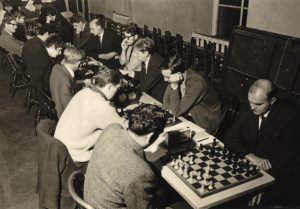
Bridgend visit Cardiff YMCA and take on Cardiff Bishops. Facing the camera on the far right is Ron Stevens with the Bridgend team to his right – Martyn Griffiths, Byron Thomas, Mike Lister, Ron Durston and John Basini.
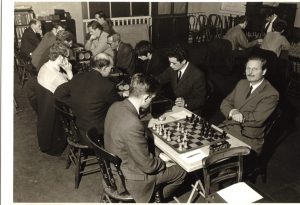
Another photo of the same match with John Basini having his back to the camera and Ron Durston to his left.
Bridgend’s B team won promotion to the First Division.
Clocks were now in use in all league matches. Gone were the days when two or three games would be played between the same opponents in one evening or one tough game would remain unfinished. The time limit however was 36 moves in 1½ hours after which games were adjudicated. This meant that endgames were a rarity. The fact that only nine (later 11) games were played in a season meant that individual clubs had plenty of time for internal club competitions and friendly matches, things which tended to disappear when leagues increased in size so that sometimes 20 league matches were played. The small number of league matches made for a vibrant club atmosphere.
The club’s first ever Lightning Chess Championship (10 seconds a move) was held on 15th May 1969 and Ron Stevens was successful scoring 7.5/8.
Many of the club’s members represented East Glamorgan in the Zonal Championships and in May 1969 Ron Stevens (Bd 7), Byron Thomas (13), Martyn Griffiths (14) and Mike Lister (19) played in the Counties quarter-final match against Oxfordshire, the opposition being almost entirely composed of University students.
Grades were introduced in Wales from about 1964 but very few players appeared on the official list. By 1969 however more comprehensive lists were being produced and players from Bridgend featured strongly:
168 Martyn Griffiths
159 Ron Stevens
159 Byron Thomas
143 Ron Durston
139 K. Foalle
138 Ken Bogue
131 Mike Lister
130 Clive Rickard
117 John Basini
115 John Burke
111 Tom Evans
109 Arthur Greenway
99 D. L. Evans
The 1969 Club Championship was played in sections with the winner of each section proceeding to the final. The underdog in the final, Ken Bogue, surprised everyone by winning all three games to take the title. Welsh Brewers presented a Cup for the winner.
At the end of the season a club dinner was held, giving the opportunity for wives and partners to find out who these strange people called chess players were. This experiment was repeated again the following year at Stoneleigh Club, Porthcawl.
The 1969-70 league season saw a return to the fold of Roger John and John Trevelyan. They competed mainly for the club’s second team, along with another strong player, Stephen Jones, who had played top board for Surrey University the previous year. Trevelyan and Jones however could not play in all the matches. Ron Durston moved up to play in the first team, taking Foalle’s place.
Both the club’s sides were now in Division One and, having split their strength, it is not surprising that the ‘A’ team finished 5th overall, losing 3 of their 11 matches. The ‘B’ team finished 8th.
The 1970 (3rd) Club Championship was won by Martyn Griffiths with 7.5/9. The tournament this year was split into sections with the best 11 players taking part in the Championship itself and the rest going into a Candidates tournament.
Byron Thomas organized a Grandmaster simultaneous display on 13th January 1970. Regrettably it had to take place in Cardiff but players from all over South Wales attended. The opponent was former Russian World Champion, Vassily Smyslov and Mike Lister was one of only five players to achieve a draw. Smyslov lost just one game out of 32 played. Ron Durston, Roger John, Arthur Greenway and John Trevelyan were among the vanquished.
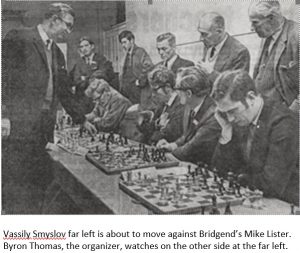
A month later, on 12th February, the British Master, Peter Clarke, gave a simultaneous display, this time at Bridgend. He demolished 13 of his opponents and only John Trevelyan managed to hold him to a draw.
At the end of the season East Glamorgan again were the Welsh qualifiers for the quarter-final of the Counties’ Championship. This time they met Cambridgeshire, a team again mainly consisting of university students. Martyn Griffiths (7), Byron Thomas (10) and Roger John (13) were the club’s representatives.
Two of the club’s members played their part in helping to organize the game in Wales. At their Annual General Meeting, Byron Thomas was appointed Secretary for the East Glamorgan League. At the Welsh Chess Union AGM, Martyn Griffiths, who had run the South Wales postal chess teams for several years, took over the running of the Welsh Correspondence Chess Championships.
The 2nd Club Lightning Championship was held on 21st May 1970 and Martyn Griffiths won with 5.5/6.
The grades were again published at the end of the season and the leading Bridgend players were:
184 John Trevelyan
172 Martyn Griffiths
163 Ken Bogue
162 Ron Stevens
153 Roger John
152 Byron Thomas
131 John Basini
131 Mike Lister
129 Ron Durston
The 4th Club Championship was again won by Martyn Griffiths after a play-off with Mike Lister. There were two sections with a total of 32 players. Geoff Hamer won the first ever Junior Championship scoring 8/9 and finishing half a point ahead of John Mason. Hamer was a very talented teenager from Llanharry.
The Club’s 3rd Lightning Tournament was won jointly by Martyn Griffiths and Geoff Hamer.
For the new 1970-1 season it was decided to enter three teams. The ‘A’ team was comprised of the same players as the previous year and achieved third place, losing only two out of eleven matches. The ‘B’ team struggled and only narrowly missed bottom place whilst the ‘C’ team finished mid table in Division Two.
Towards the end of the season some talented young players arrived at the club including Peter Crowley, Ian Abraham and, a little bit older, Mike Warden.
1971 Grades :
180 John Trevelyan
171 Martyn Griffiths
171 Byron Thomas
165 Ron Stevens
161 Roger John
159 Mike Warden
151 Ken Bogue
148 Ron Durston
131 Clive Rickard
127 John Basini
127 Don Cavalli
The start of the 1971-2 league season saw a strong Bridgend team of John Trevelyan, Martyn Griffiths, Roger John, Ron Stevens, Mike Warden and Mike Lister. Byron Thomas dropped down to lead the ‘B’ team where he was supported for part of the season by the strong English player, John Day, who hailed from Essex originally.
Bridgend B finished top of Division Two.
The 5th Club Championship was won by John Trevelyan with 9/10, losing only to Ken Bogue. By now there were three sections to the Championship and 40 entries. John Mason won the club’s second Under 18 tournament with a very young 12 year old, Clive Trevelyan, finishing second. There were 13 entries.
The new generation of young players improved their skills rapidly as they, unlike their predecessors, were able to travel the length of Britain to test and improve their skills at chess congresses. The grand finale of the chess year was the annual Easter Welsh Championships and the Bridgend club was well represented over the years by Roger John (1966, 1971 and 1972), John Trevelyan (1968, 1969, 1971 and 1972), Martyn Griffiths (1969) and Mike Warden (1971).
At the annual Welsh Junior Championships (Under 18) in 1972, Geoff Hamer and Clive Trevelyan were part of an unprecedented six-way tie for the title. The same year Clive Trevelyan became Welsh Under 13 champion.




